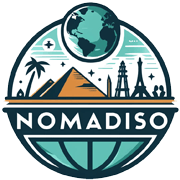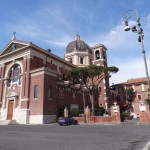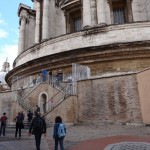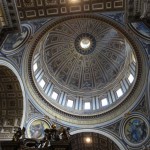We all learned about ancient Rome in history class. It spread across 7 hills on the eastern bank of the Tiber River. The center of activity was the Roman Forum, the remains of which are still preserved today. Impressive structures like the Pantheon and the Colosseum have endured for 2000 years. And what does the Eternal City look like today? Let’s try to describe it through the eyes of globetrotters thanks to cheap flights to this destination.
Contents
Day 1 – Lido di Ostia and getting to know Rome
Day 2 – Vatican Museums and St. Peter’s Basilica
Day 3 – Center of Rome
Day 4 – Pope Francis
Day 5 – Farewell to Rome
Day 1 – Lido di Ostia and getting to know Rome
We combined our flights to Rome into two parts. The journey there Budapest – Fiumicino with WizzAir, and back Ciampino – Bratislava with Ryanair. Although it may seem a bit more complicated, the reasons were the flight dates, price, and the opportunity to see the coastline near Fiumicino airport. We land at the main and largest Italian airport, Leonardo da Vinci – Fiumicino, at noon sharp at 12 o’clock. If you want to go to the beach, after exiting the main hall, turn left and follow the Regional Bus signs. Look for the Cotral bus heading to Lido di Ostia and buy your ticket at a kiosk, as it’s much more expensive on board. After about half an hour of travel, we get off at the final stop, which is actually a train station from where we’ll head back to Rome. The beach is a short walk away; we arrive at the shoreline from the left. If you want to go directly to the pier, you need to bypass it on the right. Lido di Ostia is a long coastal strip with dark gray sand. There are only kite surfers and a few brave swimmers in the water; it’s not yet suitable for swimming. The Mediterranean Sea is around 15 degrees at this time of year. We settle comfortably on the sand, dip our feet in the water, and take a stroll to the pier. On the way to the station, we pass by the Santa Maria Regina Pacis church.
The suburban trains of the Rome-Lido railway run to the beginning of the center at the Pyramid station, where you can take the metro.
TIP: For public transportation, you can choose between a 100-minute ticket for 1.50€ or a daily pass for 6€
The 100-minute ticket is valid for a continuous journey by metro, train, and buses within the time limit. We disembark at the final stop Pyramid and go to visit the first point on our itinerary – the Pyramid of Cestius. It is necessary to accept that some monuments will be under reconstruction, which is the case with this pyramid as well. We’ll take some photos of it even with the scaffolding, and then we move by bus, included in our ticket, to the Basilica of Saint Paul Outside the Walls. It is one of the four papal basilicas under the administration of the Vatican. At this moment, we don’t fully realize the smaller number of visitors, but when you reach the center of Rome, you will see a huge difference. The golden mosaics on the facade of the basilica dazzled us at the entrance of the atrium. In the center stands a statue of Saint Paul surrounded by beautifully landscaped greenery and four palm trees. The interior of the basilica is characterized by a fascinating golden ceiling and portraits of all the popes from Saint Peter to the current Pope Francis. There are spaces left for the future five popes on the wall, and what will happen next, we dare not predict.
After visiting the church, we have to make our way to our apartment because our arrival is scheduled for a precise hour. This time we arranged our accommodation through the Catholic News behind the Vatican walls. We first take the B line metro – from Basilica San Paolo to Termini, and then transfer to the A line – from Termini to Cipro. From this station, our Vaticano apartment is about a 10-minute walk. Along the way, we pass by a greengrocer and a CONAD supermarket. It must be said that the fruits and vegetables here are top quality, so shopping is a delight. We meet our landlord who hands us the keys, and we can settle in. The spaces are minimalist and furnished to the last detail. On the roof of the apartment, we have a terrace. The Vatican walls are just a few meters away, and for an evening stroll, we decide to walk all around. Every corner is monitored by cameras, and the whole Vatican appears as an impregnable fortress. After about ten minutes of walking, we pass by the entrance to the Vatican Museums, which are on our itinerary for tomorrow. A few more sharp turns, and we arrive at the colonnade, through which we enter St. Peter’s Square. I forgot my tripod in the room for night shots, but you can easily place the camera on the wooden barriers. The entire circuit around the Vatican walls takes about an hour.
Day 2 – Vatican Museums and St. Peter’s Basilica
Vatican Museums is definitely a full-day program. The museum gates open at 9 a.m., but you should arrive to queue by 8 a.m. The entrance is located to the side of the Vatican walls, and the line tends to form more there, so make sure you are standing in the right one. One line is for online ticket holders and tends to be organized groups. For others, the line forms downhill from the walls. Touts will try to sell you skip-the-line tickets at double the price while you wait. Although the line looks intimidating, by 9 a.m. it starts moving quite efficiently.
TIP: At the beginning of the tour, take a look at the spiral staircase, because with our tips you will exit later into St. Peter’s Basilica
At the spiral staircase, there is also the Vatican Post Office where you can send a postcard home. We start on the right-hand side with a tour of paintings in the Pinacoteca. Here, you can find mainly Italian paintings and the most famous painting by Raphael, The Transfiguration of Christ. In this section, we also visited Roman sculptures – the Museo Gregoriano Profano and the Museo Filatelico e Numismatico with papal stamps. On the left side, we visit the Egyptian Museum – Museo Gregoriano Egizio, Etruscan Museum – Museo Gregoriano Etrusco, and Greek and Roman antiquities – Museo Pio Clementino. On the octagonal square stands the famous Laocoön statue. Interestingly, its right arm was found after 400 years. After exiting these museums, you come to the courtyard with the pine cone – Cortile della Pigna, where you can see the Fontana della Pigna from the 1st century. In the center is the rotating globe, Sphere Within Sphere, by the Italian sculptor Pomodoro.
During the tours, you will see probably the most common sign of the visit, the Capella Sistina, which suggests that the best comes at the end. The museum continues with a long corridor where you will see one after another antiquities – Galleria degli Candelabri, tapestries – Galleria degli Arazzi, and wall maps – Galleria delle Carte Geografiche. Then you will pass through a few less interesting rooms before reaching the brilliant Raphael Rooms – Stanze di Raffaello. It is a complex of 4 rooms with the most famous frescoes like Athenian School, The Disputation, and Parnassus in the Room of the Signatura – Stanza della Segnatura. If you were amazed by the Raphael Rooms, the Sistine Chapel will leave you speechless. Upon entering the room, you will be dazzled by the divine frescoes on the walls and ceiling. The masterpiece is Michelangelo’s fresco The Last Judgment. The painting covers an area of almost 165 m² and depicts 390 figures. The central figure is Christ, conducting the judgment with his raised right hand. To his right are the chosen ones ascending to heaven, and to his left are the damned descending into the abyss, where Charon and his boat await them. The unveiling of the work caused scandalous reactions due to the nudity depicted. Photography is prohibited, and if you think it’s to protect the paintings from damage, you are wrong. The rights for photography and filming in the chapel are owned by the Japanese television company Nippon TV, which invested 4.2 million USD in the cleaning and restoration of the frescoes.
TIP: At the end of the chapel, join a guided group and exit through the right side
If you don’t do this and exit on the left, you will have to walk back through the entire Vatican Museums.
So we skipped a part of the museum and head towards the entrance to the dome of St. Peter’s Basilica, which is our next stop. You can choose to pay 5€ for the stairs or 7€ for the elevator. We opted for the stairs. First, you will reach the inside of the dome, where you’ll see the main altar and the canopy. The more exciting part is the outside terrace, which everyone has to climb. From there, you can take postcard-perfect shots of the baroque.Saint Peter’s Square, designed by Bernini, represents the church’s embrace of all believers. On the opposite side of the dome, you can see what Vatican looks like from the inside. An interesting feature is, for example, a railway track that leads there from the side across the bridge. In front of the governor’s palace is the “natural” coat of arms of the Vatican. The flag of Vatican City consists of two crossed keys of Saint Peter – a yellow one symbolizing the heavenly kingdom and a silver one representing papal power on Earth. Their message comes from the Gospel of Matthew (Mt 16:18-19): “18 And I tell you, you are Peter, and on this rock I will build my church, and the gates of Hades will not overcome it. 19 I will give you the keys of the kingdom of heaven; whatever you bind on earth will be bound in heaven, and whatever you loose on earth will be loosed in heaven.” The way down is along a different route, and you will emerge by the statues on the facade and subsequently inside the Basilica of Saint Peter. Truly remarkably designed. The basilica is 211m long, 136m tall, has a capacity of 60,000 people, and until 1990, it was the largest church in the world before being “surpassed” by the Basilica of Our Lady of Peace in the capital of Ivory Coast. Bernini’s impressive baldachin rises beneath the center of the dome, where the main nave intersects with the side ones. It is the heart of the basilica, with the Papal Altar directly above Saint Peter’s tomb. Next to it is a 13th-century statue of Saint Peter. Tourists often kiss or touch his extended foot. We have done enough walking today, but we will return here on the last day. For dinner, we taste the local kebab.
Day 3 – Rome City Center
We planned two days for exploring the center of Rome. Today, we want to make the most of it, and on Sunday, the rest after Angelus. We board the metro and start at the farthest locations near the San Giovanni stop. Our first visit is to the Basilica of Saint John Lateran, which is referred to as the “head and mother” of all the churches in the city and the world. While St. Peter’s Basilica is generally considered the spiritual center of the Roman Catholic Church, the Lateran Basilica is the highest-ranking church among Catholics hierarchically. Next to the Lateran Basilica across the street is the building of the Holy Stairs – Scala Sancta. According to tradition, these are the stairs Jesus ascended in Pilate’s palace. You can only climb the 28 steps on your knees, so we will endure it dutifully. Walking in the opposite direction of the basilica, we head to another church, Santa Croce in Gerusalemme Basilica, known for the relics of Christ’s cross. If you don’t plan your route well, you will really run yourself ragged.
We head back to the Lateran Basilica and continue on foot towards the Colosseum. Along the way, we also visitBasilica of San Clemente. Just a few dozen meters away begins the opening of the famous Colosseum. This architectural landmark of Rome was mainly used for gladiator fights, battles with wild animals, executions, and dramatic performances. It’s quite possible that you will experience some scaffolding and partial reconstruction like we did. The entrance fee of 13.50€ seemed a bit much to us, so we visited it in daylight and again at dusk. To the right of the Colosseum is a park where we had a quick lunch from our homemade supplies.
We continue towards Basilica of St. Peter in Chains, known for the chains with which Herod bound St. Peter, and Michelangelo’s statue of Moses. The largest Roman temple dedicated to the Virgin Mary is the Basilica of Santa Maria Maggiore. It is also known as Santa Maria della Neve (Our Lady of the Snows) thanks to the legend of miraculous snowfall in the middle of summer and a double Marian apparition. We board the metro at Termini station and get off at Spagna station. With a bit of luck, we emerge at the beginning of the park leading to Villa Borghese. Due to a lack of time, we skipped it from the program.
We head straight to the viewpoint of Pincian Hill, one of the most beautiful viewpoints in Rome. The views remind one of a hundred-spired Prague, with plenty of towers and domes standing out. We descend along the walls to the Church of the Most Holy Trinity, from where 135 steps lead down through the Spanish Steps – Piazza di Spagna. If we’ve seen some squares overcrowded, this one was definitely one of them. Across from the Spanish Steps is Via dei Condotti, Rome’s most luxurious shopping street, where the famous Italian actress Sophia Loren is said to reside. Following our plan, we head towards the Trevi Fountain. I can say it’s the most beautiful fountain I’ve ever seen. It has become a tradition for tourists to toss coins into the fountain to ensure a return to Rome. In a single day, about 3000€ is collected from there.
Two streets further, we arrive at the Presidential Palace Palazzo Quirinale. An official building like any other, perhaps more interesting from the inside. Our next destination on the journey is the Monument to Victor Emmanuel II, which was built in honor of the first king of unified Italy. This majestic marble building stands at 70m high and is visible from a great distance. Inside the monument, there is a museum, and from the sides, you can take beautiful panoramas. The elevator to the very top costs an unreasonable 7€, so we skipped that. Instead, you can sit in a cozy café. Behind the monument, there is a church where we happened to witness a wedding. We continue down the stairs to Capitol Hill and the Capitoline Museums. Capitol Hill is now the seat of the mayor and the Roman magistrate, with a grand staircase called Cordonata leading up to it. On the side of the monument, there is a bus stop, so finding the right bus to the Mouth of Truth should not be a problem. Legend has it that if a liar puts his hand in these mouths, he will lose it. The mouths are behind bars, and since it’s closing time, we only admire them from the outside. We spend the end of the day in the park near the church of Santa Sabina, which also offers beautiful views.
Day 4 – Pope Francis
Sunday noon is reserved for the Angelus at St. Peter’s Square where Pope Francis leads a 15-minute prayer every Sunday at 12:00. To pass the time, we take a stroll around the Castel Sant’Angelo –Castel Sant´Angelo. The entrance fee is 8.50€, but we didn’t want to rush it. We walked around the castle to the courthouse and back on the other side of the Tiber River. On the bridge in front of the castle, Ponte Sant’Angelo, there are statues of 10 angels holding artifacts related to the crucifixion of Christ. From this spot, you will take probably the best pictures of the Angel’s Castle. We want to leave enough time, so we slowly head towards St. Peter’s Square. People start gathering an hour before, and vendors will offer you flags every two meters. We negotiate the price and buy two as souvenirs. Exactly at noon, amidst loud cheering, the window of the Apostolic Palace opens. First, they throw out a carpet, and then Pope Francis appears, greeting all the people. It’s an amazing experience. The crowd slowly falls silent, and the actual prayer begins.
After the event, the square slowly empties. We try to wander down side streets so we can continue with our itinerary. The Piazza Navona is one of the most famous and beautiful squares in Rome. It is known for its three fountains, with Bernini’s Fountain of the Four Rivers in the center – Fontana dei Quattro Fiumi. We continue on to the famous Pantheon. This ancient building, constructed between 27 and 25 B.C., has stood for over 2000 years and is one of the best-preserved structures in the world. Its main feature is the circular interior, with the same height and diameter – 43.4m. Light enters from the hole at the top with a diameter of 8.92m, and if you’re wondering what happens when it rains, the answer is simple, the water drains through holes in the floor. Today it serves as a national museum and houses the tombs of Raphael, Italian kings Vittorio Emanuele II, Umberto I, and Queen Margherita. A street away, we stop at the church of Saint Ignatius of Loyola. Next is the Column of Marcus Aurelius, with reliefs depicting 116 battle scenes and victories of Marcus Aurelius.
We had planned to attend a mass in Slovak, but we arrived a bit late and even at the wrong door, so it looked like they had already closed and were not letting anyone in. During our improvisation, the wind led us to an underground room with skulls, and we also came across the Pallottine order, where a priest told us something about history and showed us underground spaces. Finally, we attend a mass in Italian in the Trastevere area near the Tiber Island Isola Tiberina. We then move towards the Circus Maximus across the Ponte Palatino to see Circus Maximus. Once the largest stadium in ancient Rome, it is now just a grassy area. On the left side of the stadium, you can find the ancient ruins of significant buildings surrounding the Roman Forum. Next is the Arch of Constantine and the Colosseum itself, which we planned to see even after dark. Evening photos of the Colosseum with a tripod are really worth it. The remains of the colonnade of the Roman Forum are also beautifully illuminated. We board the bus at the stop next to the Victor Emmanuel II Monument.
Day 5 – Farewell to Rome
In the morning, we pack up and head back to St. Peter’s Basilica with our belongings. It’s a perfect morning plan since we only caught a glimpse of it from the train earlier. The line in front of the basilica stretches to the middle of the square, but don’t be discouraged, you’ll be inside in half an hour.
TIP: On the right side of the square, you can find the marked pavement from the place of the assassination attempt on Pope John Paul II.
After passing the security check, we drop off our luggage at the cloakroom. The photo and video documentation can now begin. If you want to visit the tombs as well, the entrance stairs are on the left side of the baldachin. We have a flight from Ciampino airport at 2:30 p.m. We arrive in Bratislava on time and can conclude another great trip behind us.


































































